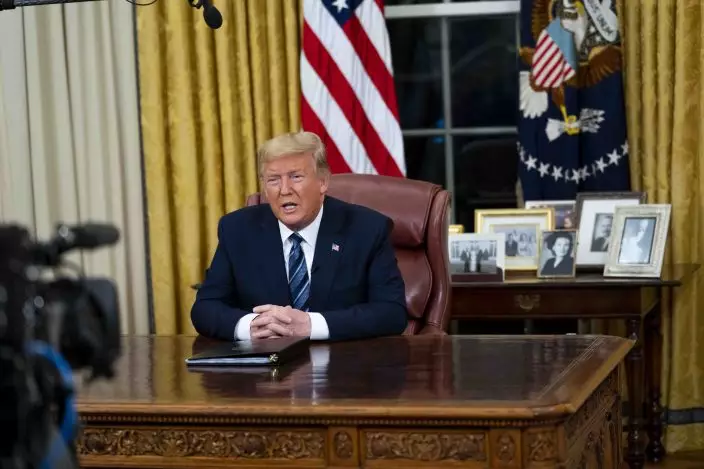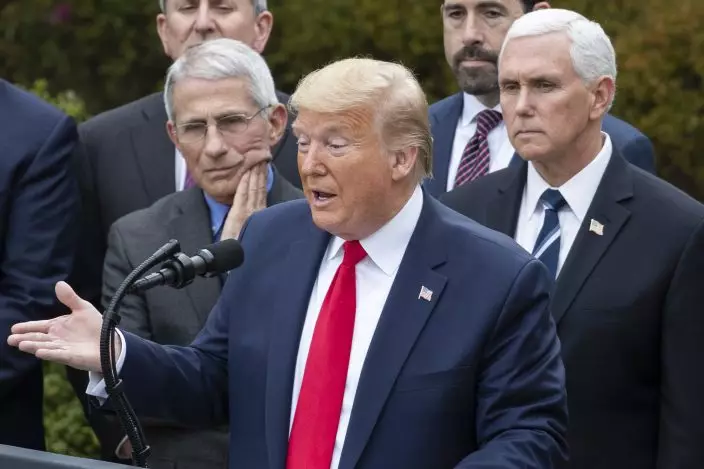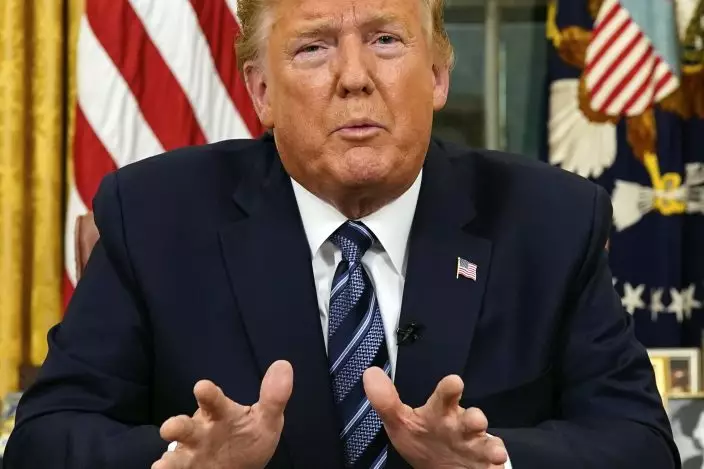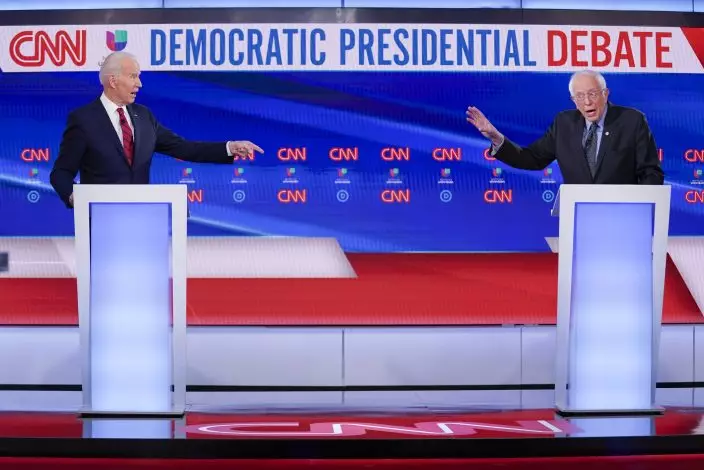Americans normally hear from President Donald Trump when he is opining on Twitter, riffing from a rally stage or otherwise improvising. This past week was different as he sat in the Oval Office with a script laid out for him to read on a matter grave enough for a prime-time address to the nation.
He addressed the coronavirus crisis that is spreading germs and fear. But his words were as factually fraught as many of his tweets.
Most broadly, Trump hailed American exceptionalism in health care and science — “The virus will not have a chance against us" — even as the public health system failed in making diagnostic testing accessible to all who need it.

President Donald Trump speaks in an address to the nation from the Oval Office at the White House about the coronavirus Wednesday, March, 11, 2020, in Washington. (Doug MillsThe New York Times via AP, Pool)
It's been more than a week now since Trump assured the country: “Anybody, right now, and yesterday, anybody that needs a test, gets a test. They're there. They have the test. And the test is beautiful."
He persisted with that thought as recently as Thursday, a day after his Oval Office address, when he asserted “the testing has been going very smooth.” This, as the government’s top infection expert, Dr. Anthony Fauci, was telling lawmakers: "It is a failing, let’s admit it.”
Meanwhile, in their first one-on-one debate matchup Sunday, Democratic presidential rivals Joe Biden and Bernie Sanders made their own questionable statements on topics including the pandemic, Social Security and more.

President Donald Trump, accompanied by Dr. Anthony Fauci, director of the National Institute of Allergy and Infectious Diseases, left, and Vice President Mike Pence, right, speaks during a news conference about the coronavirus in the Rose Garden at the White House, Friday, March 13, 2020, in Washington. (AP PhotoAlex Brandon)
A review of the recent rhetoric and reality:
EXCEPTIONALISM?
TRUMP: “No nation is more prepared or more resilient than the United States.” — Oval Office address Wednesday.
THE FACTS: American resilience will be measured over time. But the U.S. is not more prepared than all other countries. Seven weeks since the first U.S. case of coronavirus was announced, the government cannot account for what could be thousands of additional infections because of continuing stumbles on testing.

President Donald Trump speaks in an address to the nation from the Oval Office at the White House about the coronavirus Wednesday, March, 11, 2020, in Washington. (Doug MillsThe New York Times via AP, Pool)
Nearly a month after U.S. health officials promised to tap into a national network of labs that monitor for flu, that system is only just getting started. Large-scale testing is a critical part of tracking the spread of infectious diseases and allocating resources for treatment. The lack of comprehensive figures means U.S. health providers could quickly be overwhelmed by undetected cases.
Fauci told a congressional hearing that other countries grappling with the virus have been making it easy for people to get tested, but in the U.S., “the system is not really geared to what we need right now.”
For most people, COVID-19 causes only mild or moderate symptoms, such as fever and cough. For some, especially older adults and people with health problems, it can cause more severe illness, including pneumonia. The vast majority of people recover from it.

Former Vice President Joe Biden, left, and Sen. Bernie Sanders, I-Vt., right, participate in a Democratic presidential primary debate at CNN Studios in Washington, Sunday, March 15, 2020. (AP PhotoEvan Vucci)
TRUMP: "If an American is coming back or anybody is coming back, we're testing. We have a tremendous testing setup where people coming in have to be tested. ... We’re not putting them on planes if it shows positive, but if they do come here, we’re quarantining. There’s going to be a pretty strong enforcement of quarantine." -- remarks Thursday.
THE FACTS: That's not true. All people coming to the U.S. are not subject to mandatory, universal testing, nor are they being forced to quarantine.
As well, his proclamation detailing the broad travel restrictions that took effect midnight Friday night on visitors from most of Europe does not specify that everyone allowed in will have to be tested. Trump was probably referring to plans that are expected to be put in place soon to channel those arriving from many European countries to certain U.S. airports, where they will receive screening and be subjected to quarantine instructions, just like visitors from China.
TRUMP: “Taking early intense action, we have seen dramatically fewer cases of the virus in the United States than are now present in Europe. " — Oval Office address.
THE FACTS: “Seen" so far may be true. But that does not mean Europe is being hit harder by infections than the United States. Because of test shortages in the U.S., many Americans with COVID-19 aren't being diagnosed and counted.
TRUMP: "The European Union failed to take the same precautions and restrict travel from China and other hot spots. As a result, a large number of new clusters in the United States were seeded by travelers from Europe.” — Oval Office address.
THE FACTS: That's a distorted account of travel restrictions in Europe.
By the time U.S. travel restrictions were announced on Jan. 31, many major European airlines had already cut service to China. While restrictions in some European countries were not as widespread, others were much broader.
The Czech Republic had stopped issuing visas to Chinese citizens. Germany issued a travel advisory urging citizens to postpone nonessential travel to China. Italy had declared a state of emergency for six months. Russia had shut down its land border with China, as well as almost all train traffic and most flights there.
Trump on Jan. 31 signed an order that would temporarily bar entry to the U.S. of foreign nationals, other than immediate family of U.S. citizens and permanent residents, who have traveled in China within the last 14 days. The ban took effect Feb. 2.
A recent study from the journal Science found China’s internal crackdown modestly delayed the spread of the virus but it cast doubt that travel restrictions elsewhere will do much compared with other preventive measures.
Despite Trump's boast of “early intense action,” his former homeland security adviser, Tom Bossert, said restrictions on entry into the U.S. from Europe came too late. “We have nearly as much disease here in the US as the countries in Europe,” he tweeted.
WHAT'S COVERED
TRUMP: “Earlier this week, I met with the leaders of (the) health insurance industry, who have agreed to waive all co-payments for coronavirus treatments, extend insurance coverage to these treatments, and to prevent surprise medical billing.” — Oval Office address.
THE FACTS: No, they did not say they will cover copays for treatment.
As Vice President Mike Pence stated more accurately, the insurers agreed to cover coronavirus testing with no cost sharing — so no copays or deductibles. That assurance applies to tests that can confirm or rule out the virus, and doesn't extend to treatment or to other tests that the patient's doctor may order. Consumers should check with their insurance company because policies may vary on this. They should not count on the president's word.
What's more, in the process of diagnosing COVID-19, other tests may be ordered. Insurers have not pledged to waive cost-sharing for those. Copays and deductibles may apply for imaging tests such as X-rays or CT scans of the chest, for example, and hospital stays are also subject to cost-sharing.
Federal programs including Medicare, Medicaid, children’s health insurance and “Obamacare” all cover the coronavirus tests. Of particular importance, clinical diagnostic tests are covered under Medicare with no cost-sharing, a longstanding policy. But cost-sharing may apply for other tests, such as imaging.
When people get sick from the coronavirus, there currently is no antiviral treatment that can cure the disease. Instead, the current treatment is geared to relieving patients' symptoms and helping them to recover. For those who are very sick, that can involve using machinery to help them breathe. Insurers cover such treatment based on the terms of the individual's health plan, including any applicable deductibles and copays.
TESTS & TREATMENT
TRUMP: “We are cutting massive amounts of red tape to make antiviral therapies available in record time. These treatments will significantly reduce the impact and reach of the virus.” — Oval Office address.
THE FACTS: People with COVID-19 or those who get it in the outbreak should not expect those therapies to be available to them. Dr. Anthony Fauci of the National Institutes of Health told a congressional committee Wednesday that while antivirals are being tested, “we don’t know if it works. I don’t want to promise anything.”
An antiviral is a medicine that specifically attacks a virus to hasten recovery. An experimental drug named remdesivir, which was being developed to fight Ebola, is being tested in COVID-19 patients in the U.S. and abroad. There also are studies underway using combinations of some HIV-attacking drugs.
TRUMP: “For decades the @CDCgov looked at, and studied, its testing system, but did nothing about it. It would always be inadequate and slow for a large scale pandemic, but a pandemic would never happen, they hoped. President Obama made changes that only complicated things further..... Their response to H1N1 Swine Flu was a full scale disaster, with thousands dying, and nothing meaningful done to fix the testing problem, until now." — tweets Friday.
THE FACTS: His newfound disdain for the CDC’s actions and his criticisms of the Obama administration are based on a faulty description of what happened in the 2009 H1N1 pandemic, initially called “swine flu.”
Then, the CDC’s flu surveillance network actually sounded the alarm, spotting two children in California who were the first diagnosed cases of the new flu strain. About two weeks later, the U.S. declared a public health emergency and the CDC began releasing anti-flu drugs from the national stockpile to help hospitals get ready. Trump declared a state of emergency Friday, nearly two months after the first COVID-19 case in the U.S. was announced.
As for thousands dying, it actually turned out that the new H1N1 strain was less deadly than average seasonal flu. But even that comparison is problematic because regular flu years are deadliest for the elderly while H1N1 was riskiest for younger people.
TRAVEL RESTRICTIONS
TRUMP: “We will be suspending all travel from Europe, except the United Kingdom, for the next 30 days.” — Oval Office address.
THE FACTS: He inaccurately described his own plan.
First, the restriction does not apply to legal permanent residents of the U.S. or their families when they are returning from Europe. It also does not apply to U.S. citizens coming back from Europe, as Trump acknowledged.
As well, it apparently does not apply to Ireland, Romania, Croatia, Ukraine and several other European states. The proclamation released by the White House says the travel ban affects the 26 European countries in the Schengen Area. That's most of Europe, but not “all.”
TRUMP: "These prohibitions will not only apply to the tremendous amount of trade and cargo, but various other things as we get approval." — Oval Office address.
THE FACTS: That is wrong. The White House quickly clarified that the restriction on movement from Europe "only applies to human beings, not goods and cargo.”
CHEAP GAS
TRUMP: “Good for the consumer, gasoline prices coming down!” — tweet on March 9, after the price of oil fell nearly 20% and the stock market, already shaken by the coronavirus outbreak, took an even deeper dive.
TRUMP: “So with gasoline prices coming down, that’s like a tax cut. Frankly, that’s like a big tax cut, not a little tax cut for the consumer. So there’s something about that that I like.” — remarks Thursday.
THE FACTS: His affection for cheaper prices at the pump is widely shared. It's just that cheaper gas increasingly comes at a cost. The price decline could hurt overall economic growth, which is probably a bigger negative on balance than saving at the pump.
A drop in oil prices is not as helpful to the U.S. economy as it was when the country was massively dependent on foreign oil. That's because the fracking revolution has made domestic oil and natural gas production a major part of the U.S. economy. A drop in prices hurts that domestic industry. It leads to less drilling, fewer jobs, cuts in factory orders and a host of aftershocks that could leave the nation as a whole worse off.
The last time oil prices dropped by a comparable amount, in 2015-2016, it contributed to a slowing of economic growth from 2.9% to 1.6%.
DEMOCRATIC DEBATE
SANDERS: “We're the only major country on earth not to guarantee health (care for) all people. We're spending so much money and yet we are not even prepared for this pandemic.”
BIDEN: “It has nothing to do with ‘Medicare for All’ — that wouldn’t solve the problem at all.”
THE FACTS: Biden has a point. The coronavirus pandemic has taken countries by surprise regardless of the type of health care system that they have. Spain has a single-payer system, known as “social security” in that country. Italy guarantees coverage for all through a regionally based system. But both countries have struggled to get control of the outbreak, and their governments have been forced to take stringent measures not yet seen in this country.
BIDEN: “A Medicare option. We can do that now. I can get that passed. I can get that done, if I’m president of the United States of America.”
THE FACTS: That’s no guarantee. It's a promise. The health insurance industry is dead set against a public option — a government plan that would compete with private insurers — and would fight it. So would many Republicans and perhaps even some Democrats.
Democrats originally sought a public plan as part of the Obama-era Affordable Care Act. But they lacked the votes to get it through the Senate, even when they held a commanding majority in that chamber. The same fight would play out again if Biden is elected president. Whether he’s able to secure a public plan depends on the composition of the Senate.
SANDERS, to Biden: "You have been on the floor of the Senate time and time again talking about the need to cut Social Security, Medicare and veterans programs. Is that true or is that not true?"
BIDEN: “That is not true."
THE FACTS: Sanders' accusation is misleading. He suggests that Biden’s record shows that he would be hostile to preserving Social Security. In fact, Biden’s position has actually evolved over his long public career as a centrist senator. Cutting Social Security is not what he is proposing now.
Biden’s campaign has pointed to a long list of legislation he supported that increased Social Security benefits. But as an influential legislator who had a hand in passing major bills, he also was willing to enter negotiations with Republicans by considering a reduction in cost-of-living increases.
Often these changes were presented as a way to cut costs that would save the program.
During a 1996 candidate debate, for example, he floated the possibility of reducing cost-of-living increases and raising the retirement age to 68.
Sanders and his allies have also circulated video footage, news stories and transcripts of Biden's past remarks. But in some cases, what appears to be a sweeping statement by Biden lack crucial context.
One of the principal examples is a clip from a 2018 speech in which Biden appeared to discuss in favorable terms then-House Speaker Paul Ryan’s comments that a rising deficit demanded action on the popular entitlement programs. However, video, circulated on Twitter by a top Sanders adviser, used only a snippet of Biden’s remarks and avoided his larger criticism over how Ryan handled the 2017 tax cuts and subsequent budget debates.
Other widely distributed videos of Biden as a U.S. senator from Delaware in 1995 and presidential candidate in 2007 show him explaining his support for a more austere federal budget, including putting Social Security and Medicare “on the table.”
“When I argued that we should freeze federal spending, I meant Social Security, as well,” Biden said during a 1995 speech on the Senate floor. “I meant Medicare and Medicaid. I meant veterans’ benefits. ... And I not only tried it once, I tried it twice, I tried it a third time and I tried it a fourth time.”
The remarks were delivered in support of a federal balanced budget amendment that ultimately failed to win approval and did not relate directly to legislation that would have cut or frozen Social Security spending — or any other specific program. Yet as Biden himself acknowledged at the time, Social Security would likely have faced cuts if such a measure had been approved.
As the Democratic Party moved leftward — a development that tracks along ever-widening income and wealth inequality — Biden has moved with it. His 2020 campaign platform now calls for raising taxes on upper-income households to shore up Social Security and expanding benefits for some of the oldest seniors.
“There will be no compromise on Medicare and Social Security, period," Biden said Jan. 20 in Des Moines, Iowa.
SANDERS: “I voted against the bailout because I believed that the illegal behavior being done by the people on Wall Street should not be rewarded by a bailout. ... The Fed gave trillions and trillions of dollars in zero interest loans to every financial institution in this country and central banks all over the world. That was essentially a grant.”
THE FACTS: Sanders is mischaracterizing the steps taken by the Federal Reserve and the stimulus efforts by the Bush and Obama administrations as merely giveaways to banks and Wall Street. It’s true that banks disproportionately benefited from the bailout, but the layoffs and foreclosures of that time would have been even worse without the government’s fiscal and monetary intervention.
First, the Fed cut the interest rate that banks charge each other for overnight loans to near-zero in late 2008 as the economy was cratering. It also bought government debt and mortgage-backed securities that expanded the central bank’s balance sheet to historic highs. These were not grants as Sanders suggests, but efforts to increase the flow of money into the U.S. economy in order to halt the downturn and boost hiring, business investment and consumer spending.
Second, Sanders suggests that efforts such as the Troubled Asset Relief Program were in spirit rewarding bankers who should have been criminally prosecuted. But the loans and other initiatives stemming from TARP were about stabilizing the financial markets and other sectors of the economy. Biden correctly noted that failing to stabilize those institutions could have made the situation even bleaker for everyday Americans.
BIDEN: "I'm taking all the precautions. I make sure I don't touch my face."
THE FACTS: As many Americans have discovered, that's easier said than done. He defied two recommended precautions during the debate, coughing into his hand, not his elbow, and touching his face several times, once with his hand on his chin.
Associated Press writers David Rising in Berlin, Ricardo Alonso-Zaldivar, Lauran Neergaard, Josh Boak, Jill Colvin, Colleen Long, Bill Barrow, Brian Slodysko, Stephen Braun and Zeke Miller in Washington and Tom Murphy in Indianapolis contributed to this report.
EDITOR'S NOTE — A look at the veracity of claims by political figures.
Find AP Fact Checks at http://apne.ws/2kbx8bd
Follow @APFactCheck on Twitter: https://twitter.com/APFactCheck


